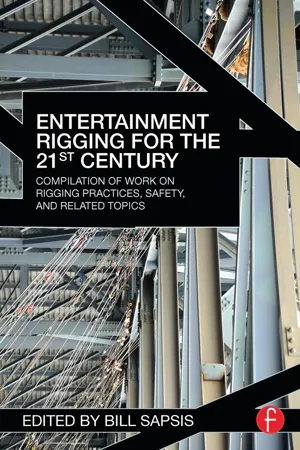
Entertainment Rigging for the 21st Century
Compilation of Work on Rigging Practices, Safety, and Related Topics
- 288 pages
- English
- ePUB (mobile friendly)
- Available on iOS & Android
Entertainment Rigging for the 21st Century
Compilation of Work on Rigging Practices, Safety, and Related Topics
About this book
From the basics of physical forces and mathematical formulas to performer flying and stage automation, Entertainment Rigging for the 21st Century provides you with insider information into rigging systems and the skills you need to safely operate them. Over the past decade, the entertainment industry has witnessed major changes in rigging technology, as manually operated rigging has given way to motorized systems in both permanent and touring productions, and greater attention has been paid to standardizing safety practices. This book leads you through what is currently happening in the industry, why it's happening, and how. Accessible for riggers and non-riggers alike, it contains details on the technology and methodology used to achieve the startling effects found in concerts and stage shows.
With a foreword written by Monona Rossol, this text contains contributions from industry leaders including:
- Rocky Paulson
- Bill Gorlin
- Tray Allen
- Roy Bickel
- Keith Bohn
- Karen Butler
- Stuart Cox
- Bill Sapsis
- Dan Culhane
- Eddie Raymond
- Chris Higgs
- Carla Richters
- Joe McGeough
- Scott Fisher
Frequently asked questions
- Essential is ideal for learners and professionals who enjoy exploring a wide range of subjects. Access the Essential Library with 800,000+ trusted titles and best-sellers across business, personal growth, and the humanities. Includes unlimited reading time and Standard Read Aloud voice.
- Complete: Perfect for advanced learners and researchers needing full, unrestricted access. Unlock 1.4M+ books across hundreds of subjects, including academic and specialized titles. The Complete Plan also includes advanced features like Premium Read Aloud and Research Assistant.
Please note we cannot support devices running on iOS 13 and Android 7 or earlier. Learn more about using the app.
Information
Forces and Formulas
Introduction
| FA | The force applied to the rigging system |
| F1 | The force at the near support or anchorage |
| F2 | The force at the far support or anchorage |
| D1 | The distance from applied force to the near support |
| D2 | The distance from applied force to the far support |
| S | The distance between supports |
| FH | The horizontal force |
| FL | The force in line with an angled leg |
| FV | The vertical force |
| DH | The horizontal distance from the anchorage to the applied force |
| DL | The length of the angled leg |
| DV | The vertical distance from the anchorage to the applied force |
| F1H | The horizontal force associated with leg 1 of a bridle |
| F1L | The force in leg 1 of a bridle |
| F1V | The vertical force associated with leg 1 of a bridle |
| D1H | The horizontal distance from the leg 1 anchorage to the bridle point |
| D1L | The leg length of leg 1 of a bridle |
| D1V | The vertical distance from the leg 1 anchorage to the bridle point |
| F2H | The hor... |
Table of contents
- Cover
- Half Title
- Title Page
- Copyright Page
- Table of Contents
- List of Contributors
- Foreword
- 1 Forces and Formulas
- 2 Structural Behavior
- 3 Lighting Truss
- 4 Arena Rigging
- 5 Outdoor Roof Structures
- 6 Counterweight Rigging
- 7 Aerialist Rigging
- 8 Performer Flying
- 9 Stage Automation
- 10 The Mechanics of Stage Automation
- 11 Training in the 21st Century (US version)
- 12 Training in the 21st Century (UK version)
- 13 Working Safely at Height
- 14 Medical Issues in Fall Arrest/Rescue
- Index